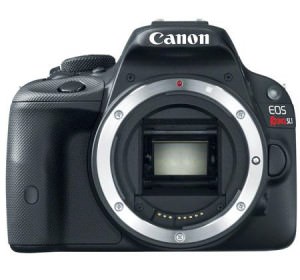- Winners make smart choices—and the Canon EF 28–135mm f/3.5–5.6 Zoom Lens offers the near-perfect focal length range for DSLR hobbyists and enthusiasts. If this describes you, then this lens will capture virtually every kind of casual image of family and friends and activities and events. Better yet, it has the focal lengths you need to learn serious portrait and landscape photography skills as well as photojournalism. You may discover a hidden aptitude for these or other forms of digital photography, which could advance the quality of your images and then justify an investment in a similar pro-level lens, such as the Canon 28–300mm f/3.5–5.6L or Canon EF 70–200mm f/2.8L.

Third-party tests reveal that the longest focal length (135mm) on the Canon EF 28–135mm f/3.5–5.6 provides a considerably wider field of view than the 70–200mm f/2.8L mentioned above, which costs approximately 5 times more. This only reinforces the wisdom of choosing the 28–135mm as an excellent all-purpose lens for the amateur with a DSLR camera.
- Another winning way of the Canon EF 28–135mm f/3.5–5.6 is the inclusion of Image Stabilization (IS) technology. Typically found in lenses with longer focal lengths, IS in this smaller Canon lens makes perfect sense if you’re one of the enthusiasts or hobbyists who will buy and use it. For maximum enjoyment of the digital photography experience, you want to be able to shoot more photos handheld of static subjects illuminated with less light available light and at lower ISO settings. It’s important that you’re always ready to take pictures without the hassle of erecting a tripod too often, looking for a structure or support against which to brace your body or selecting higher ISO settings that make your images grainy. Plus, the IS system in this Canon lens activates easily and produces very little noise.
- You’ll also capture more winning images with the lower-than-expected maximum magnification of .19x at 135mm. You’ll be able to compose very good photos of smaller natural objects, such as flowers, and explore the world of food photography or small to medium-sized still-life images.
- As an excellent choice of a general-purpose lens, the Canon EF 28–135mm f/3.5–5.6 will never seem to be a burden, so you can carry it throughout a long day at a family entertainment park or as you hike through the woods or across country in search of spectacular nature and landscape photos. The lens weighs only 19.1 oz. (540g) and its dimensions are 3.1 x 3.8” (78 x 97mm).
- Although you wouldn’t expect this lens to have a pro-like build quality, Canon certainly utilizes all it knows about manufacturing top-of-the-line pro lenses to give the 28–135mm f/3.5–5.6 solid construction, a comfortable feel in your hands and highly acceptable operational performance.
- Canon has also relied on its huge knowledge base about auto-focus motors, equipping this lens with Canon’s Ring Ultrasonic Motor (USM) that focuses with plenty of speed, silence and accuracy for the mid-level DSLR enthusiast.
- Canon didn’t scrimp on the optical characteristics either when designing the EF 28–135mm f/3.5–5.6. It comes with 16 glass elements in 12 groups; and the 6-blade aperture produces a quality bokeh, so you can learn, practice and capture portraits with pleasing background blur.
- Considering its price point, this Canon lens is a winner in third-party tests of its optical performance. Select the widest aperture (f/3.5) and you’ll discover exceptional sharpness in the center of your photos at all focal lengths. Some corner softness is evident at the wide-angle focal lengths, but this is to be expected. Plus, amateurs often forget that the pros prefer some softness, which is another reason this Canon lens will help your photos be winners.
Other optical characteristics, such as vignetting, barrel distortion and pincushioning, chromatic aberrations and lens flare, are all rated within acceptable ranges and average for a lens of this type.
- The Canon EF 28–135mm f/3.5–5.6 zoom lens will also make you a winning consumer, since it is priced at just $455.00 from B&H Photo Video at http://www.bhphotovideo.com/c/search?Ntt=Canon+28-135+f%2F3.5-5%2F6+lens&N=0&InitialSearch=yes.
Your feedback is important to thousands of PhotographyTalk.com fans and us. If this article is helpful, then please click the Like and Re-Tweet buttons at the top left of this article.
Feel free to check out any of our other photography reviews
Feel free to check out any of our other Tips and taking photo´s
Feel free to check out our Canon Forum
This post about "Canon EF 28–135mm f/3.5–5.6 Zoom Lens" was first published on our website here https://www.photographytalk.com/photography-equipment-reviews/2191-9-ways-to-be-a-winning-digital-photographer-with-the-canon-ef-28135mm-f3556-zoom-lens









 Photographers new to the DSLR experience are likely to be amazed at how well the Rebel SL1 will shoot in low-light conditions, since the ISO range is a substantial 100–12,800 (expandable to H: 25,600) for stills and ISO 6,400 (expandable to H: 12,800) for videos.
Photographers new to the DSLR experience are likely to be amazed at how well the Rebel SL1 will shoot in low-light conditions, since the ISO range is a substantial 100–12,800 (expandable to H: 25,600) for stills and ISO 6,400 (expandable to H: 12,800) for videos.